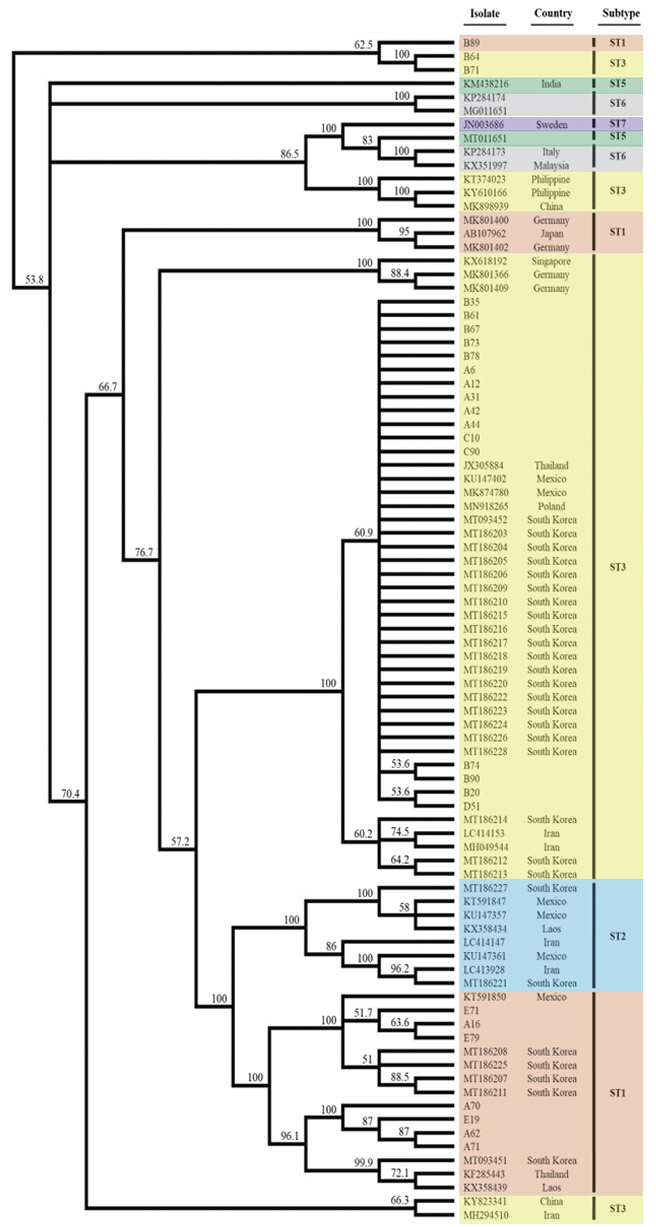Ann Clin Microbiol.
2023 Mar;26(1):11-17. 10.5145/ACM.2023.26.1.2.
Epidemiology and subtype distribution of Blastocystis among asymptomatic volunteers in Korea: a multicenter study
- Affiliations
-
- 1Department of Parasitology and Tropical Medicine, Chonnam National University Medical School, Hwasun, Korea
- 2Department of Biomedical Sciences, Graduate School of Chonnam National University, Hwasun, Korea
- 3Department of Laboratory Medicine, Gyeongsang National University Hospital, Gyeongsang National University College of Medicine, Jinju, Korea
- 4Department of Laboratory Medicine, Green Cross Laboratories (GC Labs), Yongin, Korea
- 5Department of Laboratory Medicine, Gangneung Asan Hospital, University of Ulsan College of Medicine, Gangneung, Korea
- 6Department of Laboratory Medicine, Hanyang University Guri Hospital, Hanyang University College of Medicine, Guri, Korea
- 7Department of Laboratory Medicine, Asan Medical Center, Seoul, Korea
- KMID: 2540714
- DOI: http://doi.org/10.5145/ACM.2023.26.1.2
Abstract
- Background
Blastocystis is a genus of intestinal, anaerobic protozoan parasites that can be isolated from humans, animals, and the environment. We aimed to determine the distribution of Blastocystis and subtypes (STs) using stool samples obtained from healthy volunteers at collection centers in South Korea.
Methods
A total of 478 stool samples from volunteers were collected at five collection centers throughout South Korea. The presence of Blastocystis was determined using PCR based on the small subunit (SSU) rRNA gene, and Blastocystis STs were confirmed through sequencing of the SSU rRNA gene.
Results
Molecular analysis revealed the presence of Blastocystis in 27 (5.6%) of the enrolled participants. Two STs were identified: ST3 (66.7%) and ST1 (33.3%). The positive rates of Blastocystis varied by geographical region, ranging from 1.2%–12.0%. ST3 was the predominant subtype in all centers except one, where only ST1 was isolated. Phylogenic analysis showed clustering based on ST, but no significant differences were found among the regions. There was no association between Blastocystis colonization and either age or sex of the participants.
Conclusions
The results of this multicenter study demonstrated colonization by Blastocystis, mainly ST3, in the gastrointestinal tracts of asymptomatic individuals in South Korea.
Keyword
Figure
Reference
-
1. Wawrzyniak I, Poirier P, Viscogliosi E, Dionigia M, Texier C, Delbac F, et al. Blastocystis, an unrecognized parasite: an overview of pathogenesis and diagnosis. Ther Adv Infect Dis 2013;1:167–78. .2. Parija SC and Jeremiah S. Blastocystis: taxonomy, biology and virulence. Trop Parasitol 2013;3:17–25. .3. Stensvold CR and Clark CG. Current status of Blastocystis: a personal view. Parasitol Int 2016;65:763–71. .4. Lepczyńska M, Białkowska J, Dzika E, Piskorz-Ogórek K, Korycińska J. Blastocystis: how do specific diets and human gut microbiota affect its development and pathogenicity? Eur J Clin Microbiol Infect Dis 2017;36:1531–40. .5. Rahimi HM, Pourhosseingholi MA, Yadegar A, Mirjalali H, Zali MR. High-resolution melt curve analysis: a real-time based multipurpose approach for diagnosis and epidemiological investigations of parasitic infections. Comp Immunol Microbiol Infect Dis 2019;67:101364. .6. Stensvold CR and Clark CG. Pre-empting Pandora's box: Blastocystis subtypes revisited. Trends Parasitol 2020;36:229–32. .7. Popruk S, Adao DEV, Rivera WL. Epidemiology and subtype distribution of Blastocystis in humans: a review. Infect Genet Evol 2021;95:105085. .8. Kim MJ, Won EJ, Kim SH, Shin JH, Chai JY. Molecular detection and subtyping of human Blastocystis and the clinical implications: comparisons between diarrheal and non-diarrheal groups in Korean populations. Korean J Parasitol 2020;58:321–6. .9. Chang T, Jung BK, Shin H, Hong S, Ryoo S, Lee J, et al. Genotypes of Blastocystis sp. among elderly health checkup people in South Korea with a questionnaire on risk factors. Parasitol Res 2021;120:3297–306. .10. Kim MJ, Lee YJ, Kim TJ, Won EJ. Gut microbiome profiles in colonizations with the enteric protozoa Blastocystis in Korean populations. Microorganisms 2021;10:34. .11. Javanmard E, Niyyati M, Ghasemi E, Mirjalali H, Aghdaei HA, Zali MR. Impacts of human development index and climate conditions on prevalence of Blastocystis: a systematic review and meta-analysis. Acta Trop 2018;185:193–203. .12. Belleza ML, Cadacio JL, Borja MP, Solon JA, Padilla MA, Tongol-Rivera PN, et al. Epidemiologic study of Blastocystis infection in an urban community in the Philippines. J Environ Public Health 2015;2015:894297. .13. Poulsen CS, Efunshile AM, Nelson JA, Stensvold CR. Epidemiological aspects of Blastocystis colonization in children in Ilero, Nigeria. Am J Trop Med Hyg 2016;95:175–9. .14. Jiménez PA, Jaimes JE, Ramírez JD. A summary of Blastocystis subtypes in North and South America. Parasit Vectors 2019;12:376. .15. Deng L, Wojciech L, Gascoigne NRJ, Peng G, Tan KSW. New insights into the interactions between Blastocystis, the gut microbiota, and host immunity. PLoS Pathog 2021;17:e1009253. .16. Moosavi A, Haghighi A, Mojarad EN, Zayeri F, Alebouyeh M, Khazan H, et al. Genetic variability of Blastocystis sp. isolated from symptomatic and asymptomatic individuals in Iran. Parasitol Res 2012;111:2311–15. .17. Billy V, Lhotská Z, Jirků M, Kadlecová O, Frgelecová L, Parfrey LW, et al. Blastocystis colonization alters the gut microbiome and, in some cases, promotes faster recovery from induced colitis. Front Microbiol 2021;12:641483. .
- Full Text Links
- Actions
-
Cited
- CITED
-
- Close
- Share
- Similar articles
-
- Subtype Distribution of Blastocystis in Communities along the Chao Phraya River, Thailand
- Molecular Detection and Subtyping of Human Blastocystis and the Clinical Implications: Comparisons between Diarrheal and Non-diarrheal Groups in Korean Populations
- Subtype Distribution of Blastocystis in Thai-Myanmar Border, Thailand
- Unexpected Presence of Blastocystis Subtype 1-3 DNA in Human Vaginal and Sperm Samples Coinfected with Trichomonas vaginalis
- Prevalence and Subtypes of Blastocystis in Alpacas, Vicugna pacos in Shanxi Province, China


